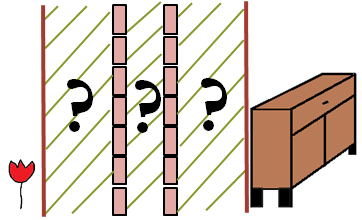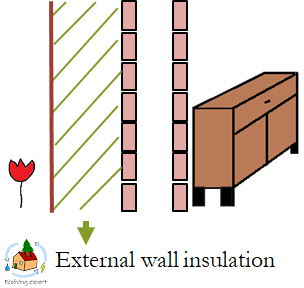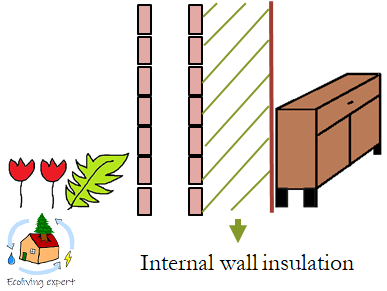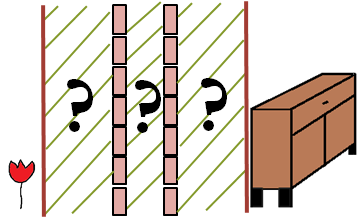Insulating the walls of your home can be a great way to reduce your climate impact and lower your energy bill. Also, it adds to more comfortable living because you reduce drafts and can reduce moisture or mold problems.

Before you start
Always take local regulations into account when planning to improve your home. Maybe local regulations force you to request a permit before making certain changes. Other measures to save energy might be subsidized in your area to achieve climate goals. If you are renting, always ask your landlord what modifications are allowed.
Before you start, find out what insulation is already present in your property. This is important to be able to determine the best way to save energy. Relatively new homes may already have cavity wall insulation, while old homes might still have single-pane windows.
If you still have single-pane glass it is important to change this to insulating double or triple glass while you insulate the walls. Furthermore, consider if insulating the roofs or floors isn’t a more effective way to save energy in the short term in your specific case.
R-values
In your search for the best way to save energy in your home you might have come across the R-value, or thermal insulation value. This is the thermal resistance per unit of area of the insulation material, or of the wall and insulation layer combined.
The R-value you need depends on your local climate. In some countries governmental or scientific organizations might advise which R-value is desirable for your region.
Take into account the units of the R-value, as sometimes SI (metric) units can be used, and sometimes I-P (inch-pound) units. This can be confusing when choosing which R-value is suitable for your house and how to achieve this. Units are not always given, so find out which country your source is from and what units are generally used there.
In case you need to convert the R-value: 1 R-value in I-P units is about 5.68 SI unit. R-value (I-P) = R-value (SI) * 5,68
The general assumption is that the R-value is linearly related to the thickness. The insulation value differs only slightly between common materials, so it largely depends on the thickness of the insulation layer.
Table 1: Wall insulation efficiency per thickness of insulating layer
| Insulation efficiency | cm | inch |
| Moderate | 5-7 | 2-3 |
| Good | 8-12 | 3-5 |
| Excellent | 13 + | 5 + |
When counting your energy savings, include savings on heating as well as energy savings on air conditioning.
Cavity wall insulation
Cavity wall insulation is the most popular way to improve the insulation capacity of houses. The cavity is the space between the inside and outside walls.

Investment costs
Investment costs for cavity wall insulation are often estimated to be returned in three to five years in a temperate climate. Your true savings depend on how you currently heat your house and to what degree. The average difference between the inside and outside of your home is hugely dependent on your climate and culture and current energy bill, so no accurate worldwide prediction is possible.
Installation
Installation needs to be done by a registered expert, but doesn’t need to be a huge task as for an average house it could be done in half a day. The installer will drill holes around 2,2 cm (0.9 inches) in the outside of the outer wall and injects insulation material through these holes. Afterward, they are often sealed with cement. This is an advantage as there is no need to remove any furniture prior to installment. A disadvantage is that you might still see the holes after installment, but if the job is done well, they should hardly be visible.
It is important to find a reliable installer, as it is difficult to check if the job is done properly. The only reliable way is to make an infrared scan of the house, which has its own costs.
Is cavity wall insulation the right choice for me?
Not every wall has a cavity that is suitable for insulation. Houses built before 1920 often don’t have a cavity at all and if your house was built in the last 20 years there is a good chance the cavity is insulated already. Also, your cavity might be smaller than 5 cm, which makes it unsuitable for cavity insulation.
Before you decide to go for cavity wall insulation, let an expert inspect the cavity for debris or moisture as well as the general condition of the walls. Cavity wall insulation is also discouraged when the wall is regularly exposed to severe driving rain or if there is a chance of flooding.
Also, don’t forget to take into account your local regulations for insulation. Maybe you need to ask for a permit or have a chance to get subsidies.
Investment costs for cavity wall insulation are lower than for external or internal wall insulation, but the insulation value is limited as the cavity has a limited width (often 4 to 7 cm/1.5 to 2.8 inches). If you want to live completely energy neutral, you probably need thicker insulation, preferably 13 cm (5 inch) or more.
Still, it can save you a good amount of energy in a short time, which makes it quickly worth the effort. At a later stage you can still add some additional internal or external insulation, but if you want an energy-neutral house within a few years you might consider directly going for internal or external wall insulation.
While insulating the cavity, consider replacing or insulating single-pane glass
If you still have single-pane glass it is important to change this to insulating double or triple glass at the same time. Otherwise you’ll lose extra heat through the window after insulating the walls and it will not be as effective. Replacing the window frame after insulating the cavity can be a bit challenging because insulation material can move out of place during the installment of the window frame. If you want to read about how to insulate single-pane glass you can read our complete guide to single-pane window insulation.
External wall insulation
If you choose to place insulation on the outside of the outer wall, the total width of the wall increases. On top of this insulation layer you can place a finisher of your choice, for example one with an authentic brick pattern.
Please check with your local authorities if external wall insulation is allowed. There is a chance that you need a permit or that external wall insulation is forbidden altogether. If you live in a monumental building it is especially likely that external wall insulation is prohibited.

Investment costs
External wall insulation is more expensive than cavity wall insulation, but the insulation value is higher because a thicker layer of material is applied. The payback time of external wall insulation is estimated at around 15 years but is of course dependent on your climate, culture, and the costs of energy and labor in your region.
These higher costs are partly due to the labor-intensive way of installation. Additionally, the chosen finish has a large influence on the price. Nevertheless the payback time is clearly longer compared to cavity wall insulation. However, the resale value of your house may increase significantly, as the property is much better insulated, better protected against weather conditions and perhaps looking better as well.
Installation
Installing external wall insulation is a job for a specialized company. Always ask for prizing at multiple companies as the variation in prices can be extensive.
Is external wall insulation the right choice for me?
Please check with your local authority if external wall insulation is allowed.
If you want to convert your home to a comfortable energy-neutral place, external wall insulation might be your best choice. Your energy bill will decrease drastically, but the payback time is longer than for cavity wall insulation because of the high installation costs.
An especially good moment to install external wall insulation is when your outer wall needs a renovation. A combined job can save you costs and your house can look good again for many years.
Other reasons to choose for external wall insulation:
- You prefer the best insulation values, for example, because you want to get to energy-neutral or live in an extreme climate
- External wall insulation doesn’t reduce your inside space, unlike internal wall insulation
- You want to maximize the comfort level of your house
- The walls of your house will look new again
Internal wall insulation
Maybe you’re not allowed to transform the outside of your house, or you don’t want to. If your walls happen to be unsuitable for cavity wall insulation you might consider placing insulation material on the living side of the internal wall.
Internal wall insulation can also be placed in addition to cavity wall insulation. You can decide to do this to further improve the total insulation value, as cavity wall insulation is limited to the width of the cavity.
By placing internal wall insulation, your living area will decrease a bit, often 10 to 13 cm (4 to 5 inches) per insulated wall.

There are different ways to insulate the internal wall:
- Use a combination of insulation material and plasterboard: Place insulation material against a framework of wooden slats or a metal profile.
- Layers of heat-reflecting foil: Stretch a few layers of heat-reflecting foil against the wall with spacers of 2cm. Finish with plasterboard or wooden battens.
- Tailored panels of hard foam insulation boards that are finished with plasterboard.
Investment costs
Internal wall insulation is more expensive than cavity wall insulation but can have a better insulation value. The insulation value depends on the heat resistance of the chosen material and the thickness of the insulation layer. Your payback time is dependent on climate, culture, and current energy bill, but is roughly estimated at 13 years.
If you do the job yourself and don’t count working hours you can reduce this to around 5 to 6 years. Please note that this remains an estimated value and it’s wise to make your own calculations for your specific situation.
Installation
Internal wall insulation is the only type of wall insulation you can install yourself, if your handy and well informed. Pay special attention to moisture before you start. If the walls are damp, first find the cause and solve it. Also make sure you add a vapor barrier to your construction to prevent wetting of the insulation layer or mold growth later on. The insulation and vapor barrier should run seamlessly to prevent indoor hot air from creeping into cracks, cool down, and leave moisture.
Make an extensive planning before you start and remember that sockets and radiator mountings also need to be adjusted.
Is internal wall insulation the right choice for me?
Internal wall insulation is sometimes the only option to reduce your energy bill and climate impact through wall insulation. It takes more effort to install than cavity wall insulation and is more expensive, but the insulation value can be higher because you can choose the thickness of the insulation layer.
Installing internal wall insulation affects the living area because you need to make room during installation and for the insulation layer itself. You can also decide to install internal wall insulation in addition to already placed cavity wall insulation to improve the total insulation value.
An advantage is that it is possible to do it yourself if you are handy and well informed. This can reduce costs but requires a large investment in terms of time. If you choose to hire an expert, ask multiple companies for pricing, as the price can differ significantly.
Internal wall insulation has a lower chance of being prohibited by your local authorities than external or cavity wall insulation. Nevertheless, check your local regulations before you start. If you are renting, always ask permission from the landlord.
Overview
When deciding which type of wall insulation is right for you, consider the following factors
- Insulation already present
- Local regulations and climate
- Personal choice of level of desirable energy savings. This determines the desired thickness of the insulation layer, which influences your options
- The existence, suitability, and width of a cavity in your walls. A cavity has a limited width, which influences the maximum thickness of the insulation layer.
- Condition and appearance of (outer) walls. If you need to renovate, external wall insulation can protect your walls and make them look new.
- Installation convenience. Internal wall insulation is the only type a handy and informed person can install without a professional. Cavity wall insulation and external wall insulation cause less hindrance during installation.
- Investment costs and payback time
The investment costs and energy savings of course depend on many factors. For example your climate and labor and material costs. Ask an expert on the energy savings, costs, and payback time of your specific case. The table below presents an indicative comparison but should be validated for your situation.
Table 2: Indicative comparison between different types of wall insulation
| Type | Potential energy savings | Investment costs | Payback time |
|---|---|---|---|
| Cavity | good | $ | short |
| External | excellent | $$$ | long |
| Internal | excellent | $($$) | moderate/long |


